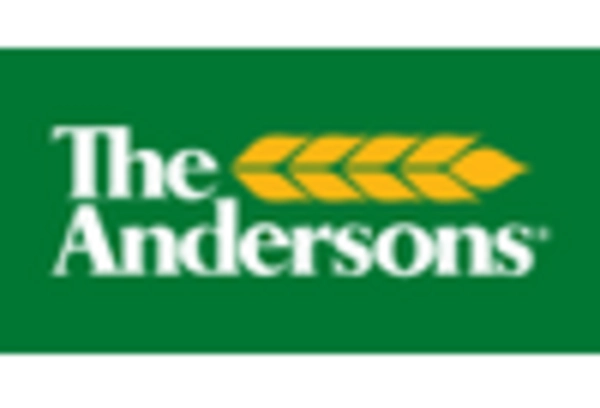Pharmaceutical Industry Growth
The Ethyl Alcohol Market is poised for growth due to the expanding pharmaceutical sector. Ethyl alcohol is a critical component in the production of various medications, antiseptics, and disinfectants. The pharmaceutical industry is projected to grow at a rate of approximately 6.3%, driven by the rising demand for healthcare products and innovations in drug development. This growth is likely to enhance the demand for ethyl alcohol as a solvent and preservative in pharmaceutical formulations. Furthermore, the increasing focus on health and wellness is expected to bolster the Ethyl Alcohol Market, as more pharmaceutical companies prioritize the use of high-quality ingredients in their products.
Regulatory Support for Biofuels
The Ethyl Alcohol Market is benefiting from regulatory support aimed at promoting biofuels. Ethyl alcohol, particularly in its bioethanol form, is increasingly recognized as a sustainable alternative to fossil fuels. Governments are implementing policies and incentives to encourage the use of biofuels, which is likely to drive the demand for ethyl alcohol in the transportation sector. The biofuels market is anticipated to grow at a compound annual growth rate of around 7.5%, indicating a strong potential for the Ethyl Alcohol Market. As environmental concerns continue to rise, the shift towards renewable energy sources is expected to further enhance the market for ethyl alcohol.
Expansion in Food and Beverage Sector
The Ethyl Alcohol Market is significantly influenced by the expansion of the food and beverage sector. Ethyl alcohol is utilized in various applications, including food flavoring, preservation, and as a solvent in food processing. The Ethyl Alcohol Market is expected to witness a growth rate of around 4.2%, which directly correlates with the demand for ethyl alcohol. Additionally, the increasing trend of craft beverages, such as artisanal spirits and specialty wines, is likely to further drive the consumption of ethyl alcohol. As manufacturers seek to enhance product quality and flavor profiles, the Ethyl Alcohol Market stands to gain from this burgeoning sector.
Rising Demand in Personal Care Products
The Ethyl Alcohol Market is experiencing a notable increase in demand due to its widespread use in personal care products. Ethyl alcohol serves as a key ingredient in hand sanitizers, perfumes, and cosmetics, which are essential in daily hygiene and grooming routines. The market for personal care products is projected to grow at a compound annual growth rate of approximately 5.5%, indicating a robust demand for ethyl alcohol as a solvent and preservative. This trend is further fueled by the growing awareness of personal hygiene and the importance of using quality ingredients in cosmetic formulations. As consumers become more discerning about product safety and efficacy, the Ethyl Alcohol Market is likely to benefit from this shift towards premium personal care products.
Technological Innovations in Production
The Ethyl Alcohol Market is experiencing advancements due to technological innovations in production processes. New methods, such as fermentation technology and continuous distillation, are enhancing the efficiency and yield of ethyl alcohol production. These innovations are likely to reduce production costs and improve the overall quality of ethyl alcohol, making it more competitive in various applications. The market is expected to see a growth rate of approximately 5.0%, driven by these technological advancements. As manufacturers adopt more efficient production techniques, the Ethyl Alcohol Market is positioned to capitalize on the increasing demand across multiple sectors, including personal care, food and beverage, and pharmaceuticals.


















Leave a Comment